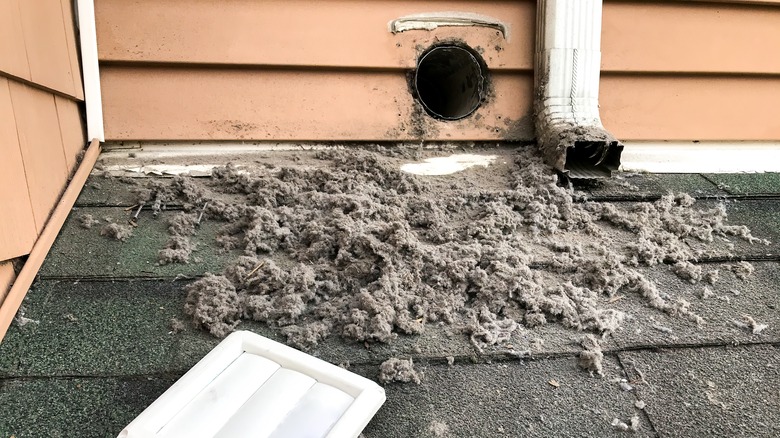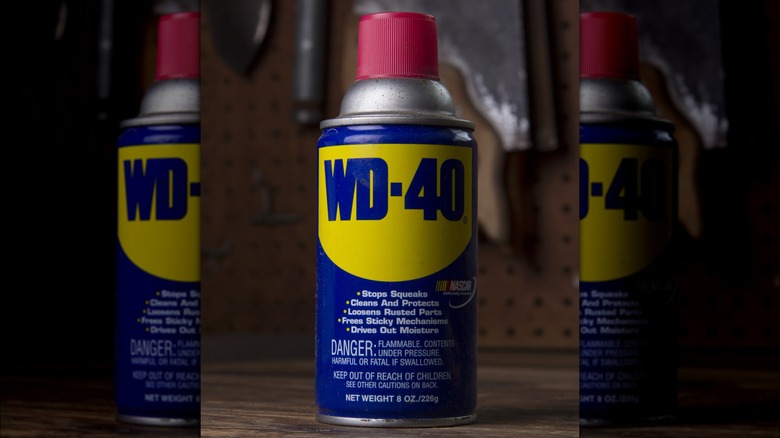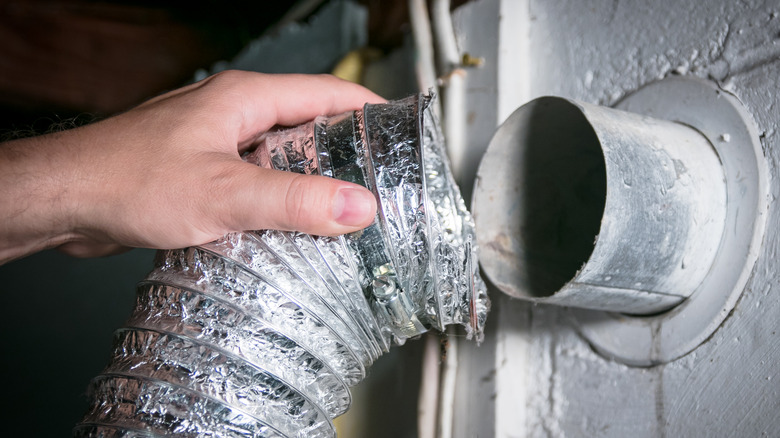Why You Should Never Reach For WD-40 When Cleaning Your Dryer Vent
Cleaning your dryer vent on a regular basis is vital. This task will increase the longevity of the appliance and help reduce the risk of fire. When attempting to clean the vent, you might discover that the slats are stuck in one position, causing you to search for a way to loosen the hinges. If you have ever considered using WD-40 to solve this problem, you might want to hear what Corey Buescher, Virtual Handyperson Expert for Frontdoor, has to say about this technique. "The dryer vent cap is already a potential blockage point for the dryer vent itself," he explained while speaking exclusively to House Digest. "Adding any type of oil- or grease-based lubricants will exacerbate the potential of creating more of a blockage at the dryer vent outlet. The dryer vent lint, dirt, and debris tend to stick to these types of lubricants."
Beyond that issue, WD-40 is actually dangerous to use in or even near a dryer vent. "Dryers produce extremely hot temperatures, and adding a product such as WD-40, which is a highly flammable lubricant, is a fire waiting to happen," Buescher explained. Because of these issues, when dealing with stubborn dryer vent components, it's best to turn to safer methods to tackle the problem. WD-40 is great to use to loosen hinges on other items, but it's best to keep it away from your dryer vent altogether.
Why using WD-40 on your dryer vent is so dangerous
Keeping your vent cap's slates clear is an important component of caring for your dryer. "The main purpose of a dryer vent cap is to keep dust or dirt, insects, and other critters from entering the dryer vent," Buescher told House Digest. "If the dryer vent cap's slates are stuck closed, the dryer will not function properly." Still, WD-40 should never be a part of this process. There are quite a few reasons why it can damage dryers, and there are two specific ways in which using it can lead to house fires. According to Buescher, this can either be due to high temperatures in and around the dryer vent or flammable lint buildup.
WD-40 can also harm certain dryer vent components. "While the use of WD-40 is safe on most materials, it can potentially degrade certain plastics or rubber over time," Buescher explained. "So, it is important to ensure compatibility with the materials in the vent." Lastly, the lubricant should not be used on dryer vents because it will ultimately need to be removed using dish soap. Otherwise, the oily residue left on your dryer components will attract lint.
How to clean your dryer vent the right way
If you're looking for guidance on how to clean your dryer vent the right way, you're in luck because Buescher broke down the process for us. You will need to start out by either unplugging your dryer or turning off its gas supply if you own a gas-powered dryer. Next, you need to gain access to the vent. "Disconnect the dryer duct from the back of the dryer and from the wall or roof vent," Buescher shared with House Digest. "You may need to move the dryer to access the duct."
With the help of a dryer vent brush kit, make sure to clean the inside and outside of your duct. "This includes the portion inside the wall, the dryer vent cap outside, and any flexible ducting," Buescher explained. After the ductwork is cleaned, identify and replace all damaged components. Next, take a look at the vent cap to ensure that it is clear of debris. Do not forget that air should be able to make its way through without any interference.
Buescher recommends repeating this process at least once a year and cleaning your lint trap regularly. That said, some homeowners will not be able to DIY this process. "If your ductwork has sharp turns or is exceptionally long, consider professional cleaning services to ensure all lint is removed properly," Buescher recommends.


